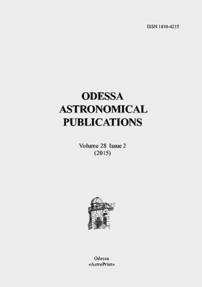THE DAILY 110 MHZ SKY SURVEY (BSA FIAN): ON-LINE DATABASE, SCIENCE AIMS AND FIRST RESULTS OF DATA PROCESSING
DOI:
https://doi.org/10.18524/1810-4215.2015.28.71037Ключові слова:
Stars, abundances – Galaxy, abundances – stars, late-typeАнотація
From 2012 on radio telescope BSA FIAN multi beams diagram was started. It capable at July 2014 daily observing by 96 beams in declination -8 .. 42 degrees in the frequency band 109-111.5 MHz. The number of frequency bands are from 6 to 32, the time constant are from 0.1 to 0.0125 sec. In receiving mode with 32 band (plus one common band) with a time constant of 12.5 ms (80 times per second) respectively produced 33x96x80 four byte real and so daily we produced 87.5 Gbt (yearly to 32 Tbt). These data are enormous opportunities for both short and long-term monitoring of various classes of radio sources (including radio transients) and for space weather and the Earth's ionosphere monitoring, for search for different classes of radio sources, etc. The base aims of our work are: a) to obtain new scientific data on different classes of discrete radio sources, the construction of physical models and their evolution - obtained on the basis of the clock continuous digital sky radio monitoring at frequency 109- 111.5 MHz and cross-analysis of data from third-party reviews on other frequencies; c) launch the streaming data on various types of highperformance computing systems, including to create a public system of distributed computing for thousands of users on the basis of BOINC technology. The BOINC client for astronomical data from the monitoring survey of the big part of entire sky almost have not analogies. We have some first science results (new pulsars, and some new type of radiosources).Посилання
Cordes J. M. et al: 2006, AJ, 637, Issue 1, 446.
Knispel B. et al: 2013, AJ, 774, Issue 2, article id. 93.
Oreshko V.V. et al : 2012, Transactions of the Institute of
Applied Astronomy (Russia), 24, 80.
Tulbashev S.A., Tulbashev V.S.: 2015, Astron. Tsirkular, 1624.
##submission.downloads##
Опубліковано
2016-06-13
Як цитувати
Samodurov, V. A., Rodin, A. E., Kitaeva, M. A., Isaev, E. A., Dumsky, D. V., Churakov, D. D., & Manzyuk, M. O. (2016). THE DAILY 110 MHZ SKY SURVEY (BSA FIAN): ON-LINE DATABASE, SCIENCE AIMS AND FIRST RESULTS OF DATA PROCESSING. Одеські астрономічні публікації, 28(2), 242–245. https://doi.org/10.18524/1810-4215.2015.28.71037
Номер
Розділ
Радіоастрономія
Ліцензія
Авторське право (c) 2015 Odessa Astronomical Publications

Ця робота ліцензується відповідно до Creative Commons Attribution-NonCommercial 4.0 International License.
Відповідно Закону України про авторське право і суміжні права N 3792-XII від 23 грудня 1993 року
